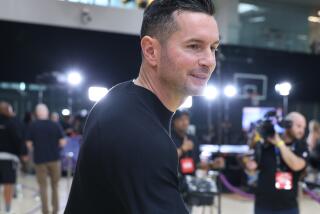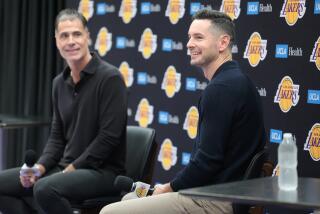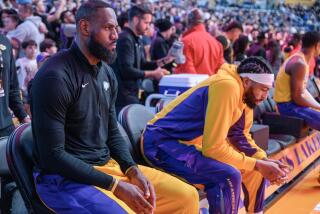Up to Their Angles
At an early age, you learn that a triangle is a three-sided polygon. Three angles, three sides. Pretty simple.
Then there’s the triangle the Lakers use, the offense that has helped Phil Jackson-coached teams win nine NBA championships. It’s considerably more complicated than most -- a triangle with so many angles that even an expert might not recognize it.
Steve Kerr, a basketball television analyst who played guard on Jackson’s title-winning Chicago Bull teams, said the Lakers scrapped their renowned offense after they lost the first two games in their second round series against San Antonio.
“They say that they run the triangle,” he said, “but they don’t run it anymore.”
Not true, say the Lakers. What they did instead was alter their attack to take better advantage of the skills of Kobe Bryant, Gary Payton and Karl Malone to go along with Shaquille O’Neal.
And they haven’t lost since.
“That’s the beauty of the offense,” said Laker assistant Tex Winter, the guru of the NBA triple post with more than 50 years of experience working the offense. “We can tweak it; that’s very easy to do. The offense is not just one option or play per se, it’s a sequence of options that they have to go through and that’s all part of the triangle philosophy.
“Most people don’t know the difference, but we get into the triangle a lot of different ways and some of the ways we get into it confuse the novice.”
The offense the Lakers used in running off four consecutive victories over the defending NBA champions certainly looked a lot different from the system that bogged down in Games 1 and 2.
In the past, the Lakers formed a floating triangle around O’Neal in the post, working passes around the perimeter until they could move the ball inside to him. That’s the attack newcomers Malone and Payton had learned as they were worked into the offense.
Now, that traditional set has been replaced by screen-and-roll-plays -- O’Neal and Malone coming farther away from the basket to set screens for the guards -- that feature the ballhandling and passing skills of Bryant and Payton.
“We’re taking advantage of the options that we have,” Malone said. “When we get into trouble is when we hold the ball and get to dribbling. To initiate our offense, it is either a shot or pass. If you catch and hold the ball, you bog it all down.”
Statistics show that turning to the screen-and-roll options of their triangle more often helped the Lakers become a more aggressive and efficient team. In the final four games of their series, the Lakers attempted 35 more free throws than the Spurs and also committed an average of nearly six fewer turnovers than they did in losing the first two games.
“What we’re doing now is designed by necessity,” reserve forward Rick Fox said. “You adapt to the personnel and their strengths.
“We’ve scaled back considerably to the point of what we’re doing now is working for us. It’s to the credit and the flexibility of the coaching staff to go with what you can go with, putting guys in position that they’re comfortable with and giving them the flexibility to do what they can do.”
Payton and Malone previously lacked that comfort level.
Payton was used to running out of a one-guard offensive set, which allowed him to dominate the ball and always be in the action. Malone came from a Utah system that had him getting the ball in traditional power forward and center spots on the floor.
In the Lakers’ triangle, Payton had to learn Jackson’s version of a two-guard offensive set, and Malone had to get used to playing with O’Neal, who forced the veteran into different spots on the floor.
“It’s hard to teach old dogs new tricks, I’ve told the team that a few times,” Jackson said Monday after practice. “The first thing is to un-learn the things that you’ve been taught.”
Injuries that put Malone on the injured list for the first time in his career also stalled the Lakers’ offensive development. Jackson lost valuable practice time working on the basic principles of the triangle. By the All-Star break, the Laker season had turned into one of survival, and veterans who knew the offense didn’t have time to help teach the team’s newer players.
Jackson refused to change his approach, hoping that once his players got on the same page, they would adjust.
“Over the five years, he’s always trying to lengthen the rope which he gives us to work with,” guard Derek Fisher said of Jackson. “As things start to go downhill, everybody looks at him and points out things they think he needs to do, but in reality, we need to be looking at the mirrors at ourselves.
“That’s what he has always stood for and has always been about. It is not about a coach having a stranglehold on a team and calling every play and telling everyone how to play. It is more about giving guys a system or format to play from and then allowing them to find their own ways within that, and then everything else kinds of works itself out.”
When Payton openly complained about his diminished role in the offense during the Lakers’ first-round series against the Houston Rockets, Jackson held his ground and the Lakers won.
But when losses in the first two games against San Antonio renewed criticism about the Lakers’ stagnant offense, Jackson listened to his coaching staff.
Jim Cleamons, the assistant who did much of the advance scouting for the Spurs’ series, said it was time to make Tim Duncan and Tony Parker, the Spurs’ offensive stars of Games 1 and 2, work on the defensive end. An adjustment was made.
“We’re initiating our offense out of a lot of screen and rolls,” Jackson said. “That’s where the triangle fits [Payton] because there’s action there.... We’ve seen a variety of things in our offense. We’ve had a circle, seen a square, we’ve seen an obtuse triangle, etc. But we still have a semblance of what we’re trying to get accomplished.”
Though he doesn’t recognize it, even Kerr acknowledged, “Whatever they’re running may be even more dangerous.”
The Lakers have breakdowns from time to time -- a subpar fourth quarter in Game 5 against the Spurs is an example of that -- but they seem to have added a productive wrinkle at a key juncture of the season.
And so, whether the Lakers’ next opponent is Minnesota or Sacramento, either will be seeing a different team than it defeated three times in four regular-season meetings.
That, Winter said, is the triangle’s “last principle.” If an offense “doesn’t utilize individual talents and abilities, it is not sound.”
More to Read
All things Lakers, all the time.
Get all the Lakers news you need in Dan Woike's weekly newsletter.
You may occasionally receive promotional content from the Los Angeles Times.






